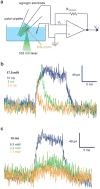Photoelectrochemical modulation of neuronal activity with free-standing coaxial silicon nanowires
- PMID: 29459654
- PMCID: PMC6029690
- DOI: 10.1038/s41565-017-0041-7
Photoelectrochemical modulation of neuronal activity with free-standing coaxial silicon nanowires
Abstract
Optical methods for modulating cellular behaviour are promising for both fundamental and clinical applications. However, most available methods are either mechanically invasive, require genetic manipulation of target cells or cannot provide subcellular specificity. Here, we address all these issues by showing optical neuromodulation with free-standing coaxial p-type/intrinsic/n-type silicon nanowires. We reveal the presence of atomic gold on the nanowire surfaces, likely due to gold diffusion during the material growth. To evaluate how surface gold impacts the photoelectrochemical properties of single nanowires, we used modified quartz pipettes from a patch clamp and recorded sustained cathodic photocurrents from single nanowires. We show that these currents can elicit action potentials in primary rat dorsal root ganglion neurons through a primarily atomic gold-enhanced photoelectrochemical process.
Figures





Comment in
-
Light touch.Nat Nanotechnol. 2018 Mar;13(3):181-182. doi: 10.1038/s41565-018-0081-7. Nat Nanotechnol. 2018. PMID: 29459652 No abstract available.
References
-
- Vetter RJ, Williams JC, Hetke JF, Nunamaker EA, Kipke DR. Chronic neural recording using silicon-substrate microelectrode arrays implanted in cerebral cortex. IEEE Transactions on Biomedical Engineering. 2004;51:896–904. - PubMed
Publication types
MeSH terms
Substances
Grants and funding
LinkOut - more resources
Full Text Sources
Other Literature Sources

